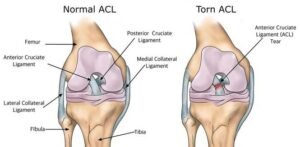In ACL reconstruction, the torn ACL ligament is removed and replaced with a piece of tendon from another part of your knee or from a deceased donor. This surgery is an outpatient procedure that’s performed through small incisions around your knee joint.
After ACL injury patient develops pain and instability in his lower limb. To stabilize it the ACL ligament surgery is required.
ACL Injury

Ligaments are strong bands of tissue that connect one bone to another. The ACL — one of two ligaments that cross the middle of the knee — connects your thighbone (femur) to your shinbone (tibia) and helps stabilize your knee joint.
Most ACL injuries happen during sports and fitness activities that can put stress on the knee:
- Suddenly slowing down and changing direction (cutting)

- Pivoting with your foot firmly planted
- Landing from a jump incorrectly
- Stopping suddenly
- Receiving a direct blow to the knee
ACL reconstruction is generally recommended if:
- You’re an athlete and want to continue in your sport, especially if the sport involves jumping, cutting, or pivoting.
- More than one ligament or the meniscus in your knee is injured
- The injury is causing your knee to buckle during everyday activities.
- You’re young (though other factors, such as activity level and knee instability, are more important than age).
Previously, anterior cruciate ligament surgery was reserved for young patients (younger than 30 years old) involved in high demand sporting activities.
However, a better understanding of complications in untreated patients, and advancement in technology resulting in decreased morbidity of the surgical procedures, the indications for anterior cruciate ligament reconstruction have broadened. This surgery is amongst commonly performing surgery for surgeons nowadays.
Question: Can An ACL Tear Heal Without Surgery?
Very minor tears (sprains) may heal with non-surgical treatments But full ACL tears cannot be healed without surgery.
For the sports and young individuals, the surgery is necessary to return to sports and their preinjury level.
ACL reconstruction is a surgical procedure. And, as with any surgery, bleeding, and infection at the surgical site are potential risks. Other risks associated with ACL reconstruction include:
- Knee pain or stiffness
- Poor healing of the graft
- Graft failure after returning to sport
General Principles of ACL Ligament Reconstruction
- Restore stability
- Maintenance of full active range of motion
- Isometric ligament function
The goals of reconstructive surgery are to restore stability and to maintain full active ROM. The functional stability provided by the normal ACL is both in resisting anteroposterior translation as well as rotational subluxation.
How You Prepare
Before your surgery, you’ll likely undergo several weeks of physical therapy. The goal before surgery is to reduce pain and swelling, restore your knee’s full range of motion, and strengthen muscles. People who go into surgery with a stiff, swollen knee may not regain full range of motion after surgery.
What You Can Expect

General or spinal anesthesia is used for the surgery depending upon the comfort and suitability of the patient. ACL reconstruction is usually done through small punctured incisions –
Through one incision a high definition Telescope is passed inside the knee joint which is connected to an advanced camera system that generates views of the inside knee joint onto the TV screen. Another incision is to allow surgical instruments to reconstruct the ligament. While surgery is seen and executed under vision at the TV screen. Even the patient can see his surgery on request.
During The Procedure
Your surgeon will remove your damaged ligament, and then replace it with a segment of tendon. This replacement tissue is called a graft and it comes from another part of your knee or a tendon from a deceased donor (ALLOGRAFT). Now here are centres in India where bone banks are developed which provide such grafts after following proper legal procedures and approval from the officials.
After The Procedure
Once you recover from the anesthesia, you can go home later that same day or next day. Before you go home, you’ll practice walking with crutches, and your surgeon may ask you to wear a knee brace or splint to help protect the graft.
Your doctor will give you specific instructions on how to control swelling and pain after surgery. In general, it’s important to keep your leg elevated, apply ice to your knee and rest as much as possible.
can shower or bathe, when you should change dressings on the wound, and how to manage post-surgery care.
Progressive physical therapy after ACL surgery helps to strengthen the muscles around your knee and improve flexibility. A physical therapist will teach you how
Results
Successful ACL reconstruction paired with focused rehabilitation can usually restore stability and function to your knee. Within the first few weeks after surgery, you should strive to regain a range of motion equal to that of your opposite knee. Recovery generally takes about nine months.
It may take eight to 12 months or more before athletes can return to their sports.
